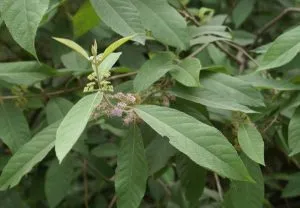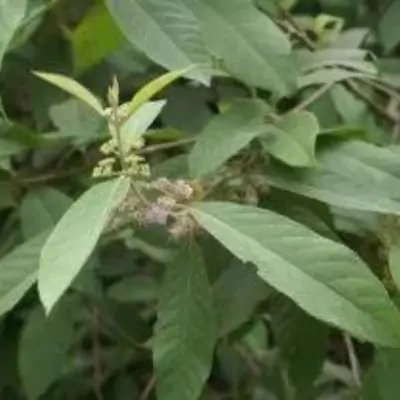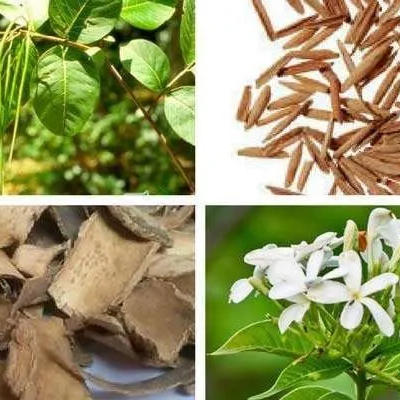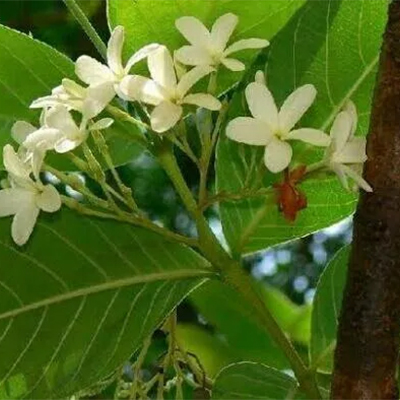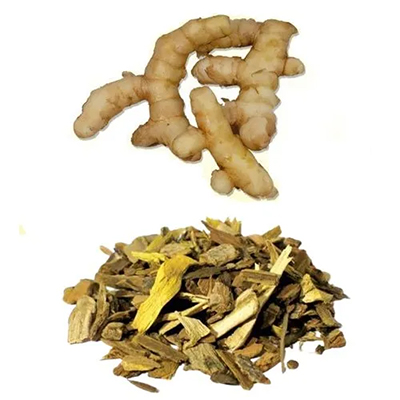On This Page
Priyangu – The Beautyberry
Introduction
Priyangu is a famous herb that is well known for its medicinal uses and controversy. Priyangu is a perennial shrub that is rightfully gaining its deserved place in the armamentarium of the modern physician. The plant of Priyangu looks very beautiful during the flowering season. Its flowers have a sweet aroma and females are attracted by its flower therefore famous with the name Mahilapriya as per Ayurveda it is Pitta Shamaka and used in various Raktaj Vikara i.e blood disorders. It contains active principles like caliterpenone, beta-sitosterol, etc due to which it exhibits various activities like anti-inflammatory, analgesic, anti-fungal, etc. This plant is also known as Phalwati and is used in various obstetric conditions.
Basonym of Priyangu
प्रियं गच्छति इति।
Priyangu has got many useful characters hence liked by many people.
Main Synonyms of Priyangu
- According to morphology
गोवन्दनी – गवि भूमौ वन्दते इति। वदि अभिवादन स्तुत्या: ।
The flowers of Priyangu are beautiful hence many appreciate them.
कारम्भा – ईषत रम्भा अथवा ईषद रम्भाकार इति।
Priyangu plant is very beautiful.
- According to properties and action
गन्धफली – गंधवत फलम अस्या: इति।
The fruits of Priyangu have a characteristic odor.
गुन्द्रा – गुन्द्रयति इति।
Priyangu will cure many ailments.
Some other important synonyms of Priyangu are:
- Mahilapriya
- Phalini
- Kanta
- Lata
- Shyama
- Aanganpriya
Regional Names of Priyangu
- Velvety beautyberry (English)
- Dahiya, Priyangu, Daya (Hindi)
- Sanna Natada Gida (Kannada)
- Chimpompi (Malayalam)
- Gavhala (Marathi)
- Sumali (Punjabi)
- Mathara, Mattraiya (Bengali)
Botanical Name
Callicarpa macrophylla Vahl.
Callicarpa is derived from two words, Kalos meaning beautiful, and Carpa meaning fruit.
Macrophylla is derived from two words Macro means large and Philla means leaf.
Family
Verbenaceae (Nirgundi Kula)
Ayurveda Reference for Priyangu (Callicarpa macrophylla)

Scientific Classification of Priyangu
| Kingdom | Plantae |
| Class | Dicotyledons |
| Subclass | Gamopetalous |
| Series | Bicarpellate |
| Order | Lamiales |
| Family | Verbenaceae |
| Genus | Callicarpa |
| Species | macrophylla |
Classification of Priyangu as per Charaka and Sushruta
- Charaka: Mutra viranjaniya Mahakshaya, Pureesh Sangrehaniya Mahakshaya
- Sushruta: Priyangvadi Gana, Anjanadi Gana
Priyangu Description in Brihtrayi
| Charaka | Shusruta | Vagbhata (Ashtang Hridya) |
| C. S. Su. 3/ 25 | S. S. Su. 6/ 24 | A. H. Su. 6/ 12 |
| C. S. Su. 4/ 5, 31, 34, 46 | S. S. Su. 14/ 37 | A. H. Su. 15/ 6, 37 |
| C. S. Su. 5/ 17 | S. S. Su. 22/ 8 | A. H. Su. 27/ 48 |
| C. S. Su. 21/ 24 | S. S. Su. 25/ 27 | A. H. Sa. 3/ 97 |
| C. S. Su. 25/ 49 | S. S. Su. 36/ 27, 29 | A. H. Ci. 2/ 16 |
| C. S. Su. 27/ 16 | S. S. Su. 38/ 24, 41, 45 | A. H. Ci. 3/ 89 |
| C. S. Vi. 6/ 16 | S. S. Su. 42/ 18 | A. H. Ci. 8/ 128 |
| C. S. Vi. 8/ 143, 151 | S. S. Su. 46/ 21, 23 | A. H. Ci. 9/ 65, 92 |
| C. S. Sa. 8/ 73 | S. S. Chi. 1/ 85 | A. H. Ci. 12/ 25 |
| C. S. In. 12/ 75 | S. S. Chi. 2/ 38 | A. H. Ci. 17/ 23 |
| C. S. Chi. 3/ 246, 258 | S. S. Chi. 8/ 44 | A. H. Ci. 19/ 25 |
| C. S. Chi. 4/ 36, 44, 66, 70, 73, 81, 94, 108 | S. S. Chi. 10/ 14 | A. H. Ci. 20/ 5 |
| C. S. Chi. 6/ 31, 41 | S. S. Chi. 11/ 5, 9 | A. H. Ci. 21/ 68, 78 |
| C. S. Chi. 7/ 132, 165 | S. S. Chi. 12/ 10 | A. H. Ka. 4/ 6, 8 |
| C. S. Chi. 9/ 42, 76 | S. S. Chi. 16/ 18, 42 | A. H. U. 5/ 10, 46 |
| C. S. Chi. 11/ 30 | S. S. Chi. 17/ 27 | A. H. U. 13/ 70 |
| C. S. Chi. 12/ 64 | S. S. Chi. 18/ 33 | A. H. U. 18/ 20 |
| C. S. Chi. 14/ 156, 228, 237 | S. S. Chi. 22/ 9, 12 | A. H. U. 22/ 9, 30, 60 |
| C. S. Chi. 15/ 155, 159 | S. S. Chi. 28/ 13 | A. H. U. 32/ 17, 23 |
| C. S. Chi. 19/ 89 | S. S. Chi. 34/ 11 | |
| C. S. Chi. 21/ 71 | S. S. Chi. 38/ 44, 46, 86, 94 | |
| C. S. Chi. 23/ 78, 223, 244 | S. S. Ka. 2/ 48 | |
| C. S. Chi. 25/ 88 | S. S. Ka. 3/ 17 | |
| C. S. Chi. 26/ 233 | S. S. Ka. 5/ 66, 73 | |
| C. S. Chi. 28/ 152 | S. S. Ka. 6/ 9, 17 | |
| C. S. Chi. 29/ 112 | S. S. Ka. 8/ 110, 131 | |
| C. S. Chi. 30/ 106, 119, 249, 263 | S. S. U. 12/ 48 | |
| C. S. Si. 3/ 36, 37 | S. S. U. 17/ 8, 41 | |
| C. S. Si. 10/ 30, 37 | S. S. U. 21/ 48 | |
| C. S. Si. 12/ 27, 31 | S. S. U. 24/ 27 | |
| S. S. U. 30/ 5 | ||
| S. S. U. 36/ 4 | ||
| S. S. U. 39/ 225 | ||
| S. S. U. 40/ 70, 72, 92 | ||
| S. S. U. 45/ 19, 33, 39 |
External Morphology of Priyangu
- Habit: Priyangu is an erect shrub, 5 to 10 feet in height.
- Branches: Branches of Priyangu have a tomentose tip.
- Leaves: Shortly stalked, lanceolate, 12 – 23 cm long, ovate or ovate-lanceolate, acuminate, the upper surface is wrinkled, white tomentose, beneath with compound stellate hairs, 12 to 16 pairs of lateral nerves are present. Short petiole up to 1 cm long.
- Inflorescence: Axillary peduncled, globose cymes.
- Flowers: Small, 5mm long, rose odor.
- Fruits: Drupes and white.
Flowering and Fruiting Time
Plant flowers during the period from July to November and fruiting begins afterward and fruits during cold months.
Types of Priyangu:
In Ayurvedic Classical texts two types of Priyangu are mentioned:
- Priyangu i.e Callicarpa macrophylla Vahl.
- Gandh Priyangu i.e Prunus mahaleb Linn.
Currently, three different plants are used under the name of Priyangu in different parts of India. They are as follows:
- Callicarpa macrophylla Vahl.
- Prunus mahaleb Linn.
- Aglaia roxburghiana Miq.
Distribution of Priyangu:
- Priyangu (Callicarpa macrophylla Vahl.) is found in the moist deciduous forests of the country including Uttar Pradesh, Orissa, West Bengal, and Chhattisgarh. It is also found in the Western Himalayas and Assam. The species is distributed in Pegu.
- Gandha Priyangu (Prunus mahaleb Linn.) – In the Mumbai region, the Phalamajja (fruit pulp) of Gandha Priyangu is used by Vaidyas. Gandha Priyangu is native to Europe, Balochistan, West Asia, and In India grown as ornamental plants.
- Aglaia roxburghiana Miq. – It occurs in the Western Ghats, Tropical Forest of South India, and Konkan.
The Useful Part of Priyangu
The useful part of Priyangu is flowers, bark, roots, and fruits.
- Callicarpa macrophylla Vahl. – Pushpa (flower)
- Prunus mahaleb Linn. – Phala (fruit) & Beej (seed)
- Aglaia roxburghiana Miq. – Phala (fruit)
Important Phytoconstituent of Priyangu
- The bark of Priyangu contains alpha – Amyrin, Ursolic acid, Betulinic acid, beta-sitosterol, and Daucosterol.
- Seeds & leaves – Seeds and leaves of Priyangu contain Caliterpenone & its Monoacetate, Beta-sitosterol, in addition, the seed also contains fatty acids.
Recent Research on Priyangu
- Anti-inflammatory
- Hepatoprotective
- Antifungal
- Anti-arthritic
- Anti-bacterial
- Analgesic
- Antidiabetic
- Cytotoxic
Rasa-Panchaka (Properties) of Priyangu
| Rasa (Taste) | Tikta (bitter), Kashaya (astringent), Madhura (Sweet) |
| Guna (Virtue) | Guru (heavy), Ruksha (dry) |
| Virya (potency) | Sheet (cold potency) |
| Vipaka (post-digestion) | Katu (pungent) |
| Dosha Karma (action on Dosha) | Mainly Vaata- Pitta Nashaka, , Rakta Stambhana, Vedna Sthapana, Tvakdoshahara, Jwarghana, Vranaropaka, Mukhdourgandhyahara, Mutravirechaniya, Dahaprashmana, Vaktrajadyahara |
Prayogarha Vyadhi (Therapeutic Indication) of Priyangu
- Raktapitta
- Rakta Vikara
- Aamvata
- Sandhivaata
- Parinaamshool
- Dourbalya
- Visha
- Jvara
- Daha
- Chardi
- Deha Dourgandhya
- Dourgandhi Vrana
- Agnimandya
- Gulma
Aamyik Paryog (Therapeutic Uses) of Priyangu
- Rakta Atisaara (Diarrhoea with blood): Paste of Priyangu mixed with honey and taken with rice water checks bleeding immediately. The patient, during treatment, should be kept on a diet of meat soup from wild animals. (Charaka Chikitsa Sthana. 19/ 33, Ashtanga Samgreha Chiktsa Sthana. 11/ 24)
- Raktapitta (Intrinsic hemorrhage):
- Powdered flowers of Khadira, Priyangu, Kovidara, and Shalmali should be taken with honey by the patient of intrinsic hemorrhage i.e Raktapitta. (Charaka Chiktsa Sthana. 4/ 70)
- Liquid gruel should be prepared with the decoction of the stamen of lotus and lily, Prishnparni and Priyangu for the patient of intrinsic hemorrhage. (Charaka Chikitsa Sthana. 4/ 44)
- Vishakta (Poisoning):
- Anti-poison formulation known as ‘Padmaka’, consisting of Priyangu, Haridra, Daruharidra, honey, and ghee is universally used in all types of spider-poisoning. (Ashtang Hridya Uttar Tantra. 37/ 71)
- One who vomits after taking in the forenoon warm bark of Priyangu pounded with rice water gets rid of the poison and disorders of Kapha and Pitta. (Vrinda Madhava. 73/ 7)
- Visarpa (Erysipelas): In erysipelas caused by Kapha, the paste of Shaivala, Nala root, Vira, and Gandhapriyangu, separately or combined, should be applied locally after mixing with profuse ghee. (Charaka Chikitsa Sthana. 21/ 90- 92)
- Parinamasula (Peptic ulcer): Emesis should be induced with the decoction of Priyangu leaves. (Vangsena Parinaamshool. 9)
- Kricha Prasava (Difficult labor): Paste the roots of Vasa, Parushaka, Priyangu, and Kakmachi separately and are applied below the umbilicus. It expels the fetus. (Chakradutta. 13/ 28)
- Dantaveshta (Spongy gums): Priyangu, Mustaka, and Triphala all combined should be applied. (Chakradutta. 56/ 11)
Important Benefits of Priyangu:
- Fever (Jvara): Priyangu is a drug with cold potency, due to this virtue it is used to treat fever and any kind of Daha (burning sensation) in the body.
- Acne, pimples (Mukhadushika): Priyangu due to its anti-bacterial, anti-inflammatory, anti-fungal properties, etc very beneficial for skin and face. It not only provides relief from acne and pimples but also helps to lighten the skin tone.
- Immune booster and strength provider (Oja Vardhaka, Balya): Priyangu removes harmful free radicals from the body with its antioxidant properties. Along with boosting immunity, it improves the overall strength of the body when taken with milk.
- Swelling and Pain (Shotha and Shool): Priyangu with its anti-inflammatory properties helps to relieve Shoth and Shool. Thus, very helpful in joints pain conditions.
Matra (Therapeutic Administration and Dosage) of Priyangu
- Churna (Powder): 3 to 6 grams

Have A Health Issue?
Consult Online
- Dr. Sahil Gupta (B.A.M.S., M.H.A.)
Ayurvedic Allergy Specialist
CEO & Founder of IAFA®
Classical Reference of Priyangu (Callicarpa macrophylla)
Bhava Prakasha Nighantu Karpuradi Varga, 102- 103
प्रियङ्गु गन्धप्रियङ्गु
प्रियङ्गु शीतला तिक्ता तुवरा अनिल पित्तह्यत।।
रक्तातीसारदौर्गन्ध्यस्वेददाहज्वरापहा ।
(वान्तिभ्रान्त्यतिसारघ्नि वक्त्रजाड्यविनाशिनी)।।
गुल्मतृड्विषमोहघ्नी तद्वद गंध प्रियंगुक ।।
Bhava Prakasha Nighantu Karpuradi Varga, 104
प्रियंगु फल
तत्फलं मधुरं रुक्षं कषायं शीतलं गुर।
विबन्धाध्मानबलकृत्संग्राही कफपित्तजित्।।
Kaiyadeva Nighantu Aushadhiadi Varga, 1352- 1356
प्रियंगु
प्रियंगु फलिनी कान्ता प्रियाहद: वनितालता।।
श्यामा गोदन्तिनी वृत्ता कङ्गुनि प्रियवल्लिका।
गन्धप्रियङ्गु
गंधप्रियंगुर्महिला करम्भा वर्णमदनी।।
गुन्द्रा गन्धफली श्यामा विश्वक सेनाअंगनाप्रिया।
प्रियंगु द्वयसामान्यगुणा:
फलिनी शीतला तिक्ता तुवरानिलपित्तह।।
रक्तातियोगदौर्गन्ध्यस्वेददाहज्वरापहा।
गुल्म तृण विषमोहघ्नी तद्वद गन्ध प्रियन्गुका।।
फल गुण
तत्फलं मधुरं रूक्षं कषायं शीतलं गुरु।
विबन्धाध्मानबलकृत् संग्रहि कफ पित्तजित्।।
Raja Nighantu, Aamradi Varga, 44-46
प्रियङ्गु
प्रियङ्गु फलिनी श्यामा प्रियवल्ली फलप्रिया ।
गौरी गोचन्दनी वृत्ता कारम्भा कङ्गु कङ्गुनि ॥
भङ्गुरा गौरवल्ली च सुभगा पर्णभेदिनी।
शुभा पीता च मङ्गल्या श्रेयसी चङ्क्भूमिता ॥
प्रियङ्गु गुण
प्रियङ्गु शीतला तिक्त दाहपित्तासदोष जित्।
वान्ति भ्रान्ति ज्वरहरा वक्त्र जाड्य विनाशिनी ॥
Vrind Madhava, Vamana Adhikara
वमने
तण्डुलसलिलनिपिष्ट य: पीत्वा वमति नर: पुर्वाह्नि।
फलिनीवल्कलम उष्णं हरति परं सकफपित्तरुजम्।।
Charaka Samhita, Chiktsa Sthana. 19/ 87
रक्तातिसारे
पीत: प्रियङ्गुकाकल्क: सक्षौद्रस्तण्डलाम्बुना।
रक्त स्त्राव्म जयेच्छीघ्रं धन्वमांसरसाशिन:।।
Charaka Samhita, Chiktsa Sthana. 4/ 68
रक्त पित्त
कोविदार प्रियंगुणाम।
पुष्पचूर्णानि, मधुना लिह्मान्ना रक्तपित्तिक:।।
Charaka Samhita, Chiktsa Sthana. 21/ 91, 92
कफविसर्पे
शैवालं नलमूलानि वीरा गन्ध प्रियन्गुकौ ।
पृथगालेपनं कुर्याद् द्वन्दशः सर्वशो अपि वा।।
प्रदेहा: सर्व एवैते देया: स्वल्पघृताप्लुता:।।
Chakradutta, 56/ 11
दन्तरोगे शीतादे
प्रियङ्ग्व्श्च् मुस्ता च त्रिफला च प्रलेपनम्।
Vrind Madhava, 73- 7
विष
तण्डुलसलिलनि पिष्टं यः पीत्वा वमति नर: पुर्वाहे ।
फलिनी वल्कलं उष्णं हरति परं सकफपित्त रुजं।।
Ashtanga Hridya, Uttara Tantra, 37 – 11
फालिनी द्वि निशा क्षौद्र सर्पिभि: पद्मकाह्वय:।
अशेष लूता कीटानाम अगद: सष्कार्मिकः।।
Ashtanga Sangreha, Chikitsa Sthana, 11- 24
रक्त अतिसार
तेन (तण्डुल उदकेन) वा समाक्षिकं फलिनी कल्कम ।
अथवा ससिता क्षौद्रं चन्दनं।।
Chakradutta, 43- 16
विद्रधिचिकित्सायां पाठाचूर्णम्
शमयति पाठामूलं क्षौदसंयुक्तम तण्डुल अम्बुनाम पीतम्।
अन्तरभूतंविद्रधिमुद्धतमाश्वेव मनुजस्य।।
Charaka Samhita, Chiktsa Sthana. 19/ 83
प्रियङ्गु पुष्पः कल्कः रक्त अतिसारे
पीतः प्रियङ्गुका कल्क: सक्षौद्र तण्डुलाम्भसा।
रक्तस्रावं जयेच्छीघ्रं धन्वमांसरसाशिन:।।
Charaka Samhita, Chiktsa Sthana. 4/ 81
प्रियंगवादिपेयं रक्तपित्ते
प्रियङ्गुकाचन्दन लोध्र सारिवा मधूक मुस्तामयधातकीजलम्।
समृत्प्रसादम सह यष्टिकाम्बुना सशर्करं रक्त निबर्हणं परम ॥
Charaka Samhita, Chiktsa Sthana. 4/ 70
प्रियङ्गु चूर्ण रक्तपित्ते
खदिरस्य प्रियङ्गु कोविदारस्य शाल्मले:।
पुष्पचूर्णानि मधुना पद्मानां केशरस्य च॥
Dhanwantri Nighantu
प्रियंगु शीतला तिक्ता मोहदाहविनाशिनी।
ज्वर वान्तिहरा रक्तमुद्विक्त च प्रसादयेत।।
Charaka Samhita, Chiktsa Sthana
गन्ध प्रियङ्गु शोणितपित्तातियोगप्रशमनानाम्।।
Madanpala Nighantu
प्रियङ्गुः शीतला वान्ति दाह विनाशिनी।
मुख कान्ति प्रजनना गात्रदौर्गन्ध्यनाशना।।
Charaka Samhita, Chiktsa Sthana. 4/ 106
प्रियङ्गुकाचन्दनरुषितानां स्पर्शा: प्रियानाच्च वराङ्गनानाम्।
Chakradutta, 43/ 19
विद्रिधि रोपन प्रियङ्ग्वादि तैलं
Vangasena, Parinaam shool. 9
परिणामशूले
प्रियङ्गु पत्र क्वाथेन वमनं परिशस्यते।
Vaidya Manorma, Patola, 13 – 28
गर्भ निष्क्राम योग
वासा परुष फलिनी काकमाची शिफा: पृथक्।
पिष्टा नाभेरयो लिप्ता गर्भ निष्क्रामण प्रदाः।।
Specific Formulation of Priyangu
- Priyangvadi Taila – For Shweta Pradara and Yoni Roga
- Priyangvadi Churna – For Nasagata Raktstrava
- Dashmularishta – For Aruchi and Chardi
- Chandana Aasava – For Mutra Vikara and Phiranga Roga
- Another important formulation of Priyangu is Drakshadi Kwath and Kumkumadi Ghrita, Devdar Arishta, Ushir Aasava, Pippliyasava, jeerakadi Modaka, Vyaghri Taila, Kanak Taila.
Contraindication and Side Effects of Priyangu
- No side effects are known or reported after the use of Priyangu.
Suggestive Reading Regarding Priyangu
- Paprikar, M., & Paprikar, M. (2021). A systematic review of Priyangu (Callicarpa macrophylla). Journal of Ayurveda and Integrated Medical Sciences, 6(5), 227 – 233. Retrieved from https://www.jaims.in/jaims/article/view/1445
- Tripathi YC, Nishat A, Lokesh U. In vitro Evaluation of Antifungal Activity of Callicarpa macrophylla Vahl Leaves. Organic & Medicinal Chem IJ. 2017; 1(5): 555571.DOI: 10.19080/omcij.2016.01.555571
- Yadav V, Jayalakshmi S, Singla RK and Patra A: Ex vivo screening of stem extracts of Callicarpa macrophylla Vahl for antifungal activity. Indo Global J Pharm Sci. 2012; 2(2): 103-107.
- Ramesh P, Talha Jawaid. Hepatoprotective activity of aerial parts of plant extract of Callicarpa macrophylla in rats. Pharmacy and Pharmacology Research. April 2014; 2(1): 1-8.
- Santosh Kumar Gupta, Amit Gupta, Gupta AK, Dhirendra Prakash, Vedpal. In vitro Anti-arthritic activity of ethanolic extract of Callicarpa macrophylla flower. Int. Res. J. Pharm. 2013; 4(3):160-162.
- Yadav V, Jayalakshmi S, Singla RK and Patra A: Preliminary assessment of the anti-inflammatory activity of Callicarpa macrophylla Vahl. leaves extracts. Indo Global J Pharma Sci. 2011; 1(3): 219-222.
- Chaudhary A, Bhattacharya A, Mitra SR, & Adityachaudhary N. Phytochemical investigation on the leaves of Callicarpa macrophylla Vahl. J Indian Chem Soc. 1978; 55:628–629.
- Leeratiwond C, Chantaranothai P, Paton AJ. A synopsis of the genus Callicarpa L. (Lamiaceae) in Thailand. Thai Forest Bull., Bot. 2009; 37:36-58. https://li01.tcithaijo.org/index.php/ThaiForestBulletin/article/view/24334
- Chandra M, Prakash O, Kumar R, Bachheti RK, Bhushan B, Kumar M, Pant AK. β-Selinene-Rich Essential Oils from the parts of Callicarpa macrophylla and their antioxidant and pharmacological activities. Medicines. 2017; 4(3):52. https://doi.org/10.3390/medicines4030052
- Wanjari, Manish. (2014). CALLICARPA MACROPHYLLA: A REVIEW OF ITS PHYTO-CHEMISTRY, PHARMACOLOGY, FOLKLORE CLAIMS, AND AYURVEDIC STUDIES.
References
- Agnivesha, Charaka, Dridhabala . In: Charaka Samhita, ed. Vaidya Jadavaji Trikamji Aacharya., editor. Varanasi: Chaukhamba Sanskrit Sansthan; 2009.
- Sushruta. In: Sushruta Samhita, Sutra Sthana, ed. Vaidya Jadavji Trikamji Acharya., editor. Varanasi: Choukhambha Orientalia; 2005.
- Vagbhata. In: Ashtanga Hrudaya, 9th ed. Anna Moreshwar Kunte, Krishnashastri Navarre, Harishastri, editors. Varanasi: Choukhambha Orientalia; 2005.
- Bhavamishra. In: Bhava Prakasha Nighantu, Karpuradi Varga 11th ed. part 2. Brahma Shankara Mishra., editor. Varanasi: Choukhambha Bharati Academy; 2009.
- Bhavprakasha, commentary by Bulusu Sitaram, forwarded by K.C.Chunekar
- Sharma PV, Kaideva Nighantu. Aushadhi Varga. Chaukhamba Orientalia, Varanasi; 2006:
- Tripathi I., Raja Nighantu, Chandanadi, aamradi Varga, Chaukhamba Krishnadas Academy; Varanasi; 2010
- Dr. Gyanendra Pandey, Dravyaguna Vigyana, reprint 2012, Chwkhamba Krishnadas Academy
- K.niteshwar Dravyagunavigyana, reprint 2017.
- Dr. J.L.N. Sastry and Dr. B.S. Sastry, Dravyaguna Vigyana, Chaukhambha Orientalia, Varanasi.
- Chakrapanidatta, chakradatta with the vaidayaprabhahindi commentary by indradevatripathi, chaukambha sankritasansthan, varanai 2nd Edition, 1994.
Ayurveda is an Indian system of medicine that is popular since ancient times. Dr. Gupta’s IAFA® has been conducting research studies to find out different phytoconstituents of herbs and their action in the body. Such knowledge acquired by our experts is used in the preparation of medicines and providing the treatment facilities safely and effectively. IAFA® is the provider of safe and effective treatment for a wide range of diseases, mainly allergic diseases all based on Ayurveda.

